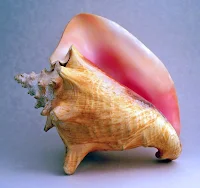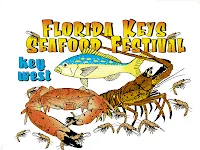 France, England and New England. A rich melting pot of culture and influence, the indigenous cuisine came to incorporate diverse and delicious nuances, with a reliance on an abundant array of fish and seafood harvested from surrounding waters. For more about the Florida Keys, check out the History & Origins of The Keys.
France, England and New England. A rich melting pot of culture and influence, the indigenous cuisine came to incorporate diverse and delicious nuances, with a reliance on an abundant array of fish and seafood harvested from surrounding waters. For more about the Florida Keys, check out the History & Origins of The Keys. Commercial fishing, in fact, is the second-largest industry in the Keys. The fresh fish that grace a restaurant table at night is more than likely unloaded at the docks
 that morning, and fish and seafood headline nearly every restaurant menu. Among the favorites are Key West Pink Shrimp, a delicacy generally considered sweeter than other crustaceans. Key West pinks rank among the most popular of the Keys' "natural resources."
that morning, and fish and seafood headline nearly every restaurant menu. Among the favorites are Key West Pink Shrimp, a delicacy generally considered sweeter than other crustaceans. Key West pinks rank among the most popular of the Keys' "natural resources." The Mollusk Conch (pronounced konk) is served in many mouthwatering forms: lime-kissed salad, spicy Caribbean chowder and golden deep-fried fritters among them. Conch chowder can either be tomato-based or white,
 but don't expect to find any consistency of recipes from one restaurant to another. Keys' eateries pride themselves on creating unique interpretations of classic dishes.
but don't expect to find any consistency of recipes from one restaurant to another. Keys' eateries pride themselves on creating unique interpretations of classic dishes. As well as savoring the taste of conch, Keys' residents admired the mollusk's tough, hardy nature so much that they adopted its name for themselves. Today, Conch is no longer fished in the Keys, but the word Conch refers to someone born in this island chain, also affectionately known as the Conch Republic.
Stone Crabs, renowned for their sweet and succulent meat are also a popular delicacy and what most may find surprising, a sustainable and self renewable resource. Because nearly all of the crab's meat is contained within its grapnels (claws), these are the only portions of the crustacean that are harvested. Once the claws
 are removed, the crab is returned to the sea where, over the course of up to two years, the claws regenerate. It is for this reason that stone crabs are considered a renewable resource, and the Florida Keys are responsible for about 40 percent of the state's overall harvest. Florida's stone crab season runs from Oct. 15 to May 15.
are removed, the crab is returned to the sea where, over the course of up to two years, the claws regenerate. It is for this reason that stone crabs are considered a renewable resource, and the Florida Keys are responsible for about 40 percent of the state's overall harvest. Florida's stone crab season runs from Oct. 15 to May 15. Fish and Seafood Delights
Yellow-tail snapper, hog snapper, mutton snapper, grouper, dolphin or mahi-mahi, are just a few of the Keys' scale fish preferred by chefs. At restaurants throughout the island chain, diners can find sautéed yellow-tail or snapper with a variety of sauces and accompaniments, along with fried grouper or mahi-mahi sandwiches, broiled or blackened fish entrees and much more. In addition to offerings from the sea, Keys cuisine reflects a multitude of cultural influences, particularly Cuban in Key West. Migrating across the water by the thousands in the late 1800s, Cuban aristocrats and cigar makers brought the flavors of their homeland with them. Ropa vieja, a name that literally means "old clothes,"
 tastes like heavenly shredded beef. Other favorite dishes are picadillo and roast pork or pork chunks. Cuban entrees are most often served with traditional black beans and yellow rice, sweet plantains and Cuban bread. Surprisingly, some of the best Cuban sandwiches, Cuban bread stuffed with meat and cheese and warmed in a press, can be found at take-out stands attached to many island laundromats. And many savvy residents can't start the day without a breakfast of toasted Cuban bread and Cuban coffee, which packs a ferocious jolt. Gourmets visiting the Keys will find (among others) French, Italian, German, Chinese, Caribbean, Thai, Japanese and vegetarian restaurants, as well as steak houses and establishments featuring casual American fare and "comfort food."
tastes like heavenly shredded beef. Other favorite dishes are picadillo and roast pork or pork chunks. Cuban entrees are most often served with traditional black beans and yellow rice, sweet plantains and Cuban bread. Surprisingly, some of the best Cuban sandwiches, Cuban bread stuffed with meat and cheese and warmed in a press, can be found at take-out stands attached to many island laundromats. And many savvy residents can't start the day without a breakfast of toasted Cuban bread and Cuban coffee, which packs a ferocious jolt. Gourmets visiting the Keys will find (among others) French, Italian, German, Chinese, Caribbean, Thai, Japanese and vegetarian restaurants, as well as steak houses and establishments featuring casual American fare and "comfort food." When it comes to desserts, it's almost impossible to spend time in the Keys without sampling Key Lime pie. Just as New Orleans is famed for its gumbo and Chicago for its Deep Dish pizza, the island chain is known for its signature dessert. There are no commercial Key Lime groves in the Florida Keys today, but Key Largo boasted a large Key Lime industry until about the mid 1930s. Restaurants throughout the Florida Keys and Key West continue to use Key Limes and their juice to enhance seafood dishes and sauces, as well as in pies.
 According to the owner of Key West's Curry Mansion Inn, a woman named Aunt Sally, the cook for estate owner William Curry, made the first Key Lime Pie. Key West historian Tom Hambright, on the other hand, surmises that Aunt Sally likely perfected a delicacy created by area fishermen. Today, each restaurant places its individual hallmark on this special dessert, but its primary ingredients are condensed milk and tiny yellow Key Limes. Often nestled in a graham cracker crust and smothered in whipped cream, Key Lime pie is a sinfully indulgent finale for any island meal.
According to the owner of Key West's Curry Mansion Inn, a woman named Aunt Sally, the cook for estate owner William Curry, made the first Key Lime Pie. Key West historian Tom Hambright, on the other hand, surmises that Aunt Sally likely perfected a delicacy created by area fishermen. Today, each restaurant places its individual hallmark on this special dessert, but its primary ingredients are condensed milk and tiny yellow Key Limes. Often nestled in a graham cracker crust and smothered in whipped cream, Key Lime pie is a sinfully indulgent finale for any island meal. As rich as Key lime pie is, however, it can't compare to the richness of experience awaiting visitors to the Florida Keys. Whether feasting at a water's-edge seafood shack or a gourmet emporium, visitors will find a warm welcome, an easygoing atmosphere and a unique and memorable dining experience. Described as 'Floribbean', Florida Keys' cuisine incorporates local seafood and tropical fruits alongside Caribbean and Cuban influences. The culinary tradition of Key West's near neighbor, Cuba, is saluted in Cuban dishes such as ropa vieja and picadillo, typically partnered with black beans and yellow rice.
 The waters of the Keys are home to a wealth of fish such as Yellow-tail snapper, tuna and mahi-mahi - all staples on local restaurant menus. For instance, the Yellow-tail Largo is a fresh catch of snapper sautéed with shrimp, artichoke hearts and capers in a lemon-white-wine sauce. Marinated conch ceviche, pan-seared tuna and seasonal items such as sweet Key West pink shrimp are just a few of the many other dishes that delight the palates of residents and visitors alike. Seafood enthusiasts can even enjoy the satisfying taste of their own catch in one of the many restaurants which offer a 'cook the catch' option. Many restaurants will allow you to bring in your bounty after a day of fishing, and offer to cook it for you in a variety of ways. Try doing that in New York
The waters of the Keys are home to a wealth of fish such as Yellow-tail snapper, tuna and mahi-mahi - all staples on local restaurant menus. For instance, the Yellow-tail Largo is a fresh catch of snapper sautéed with shrimp, artichoke hearts and capers in a lemon-white-wine sauce. Marinated conch ceviche, pan-seared tuna and seasonal items such as sweet Key West pink shrimp are just a few of the many other dishes that delight the palates of residents and visitors alike. Seafood enthusiasts can even enjoy the satisfying taste of their own catch in one of the many restaurants which offer a 'cook the catch' option. Many restaurants will allow you to bring in your bounty after a day of fishing, and offer to cook it for you in a variety of ways. Try doing that in New YorkKeys' Spiny Lobster
Unlike stone crabs, lobsters found in the Keys, like those found throughout the Caribbean, are claw-less. Known as spiny lobster, they offer sweet and tender meat. Lobster season runs from Aug. 6 to March 31. It does not get any better than succulent Caribbean-Florida Lobster. The Keys' claw-less crustaceans are famous for their sweet, juicy and tender meat. Lobster is served steamed with clarified butter, paired with a seasoned stuffing, in a rich bisque, or cold in savory salads topped with creamy dressing.Bon Appetit,



No comments:
Post a Comment